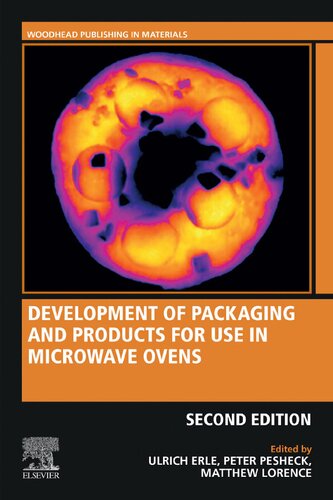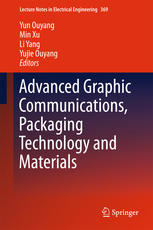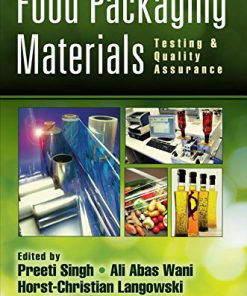Development of Packaging and Products for Use in Microwave Ovens 2nd Edition by Ulrich Erle, Peter Pesheck, Matthew Lorence ISBN 0081027133 9780081027134
$50.00 Original price was: $50.00.$25.00Current price is: $25.00.
Development of Packaging and Products for Use in Microwave Ovens 2nd Edition by Ulrich Erle, Peter Pesheck, Matthew Lorence – Ebook PDF Instant Download/Delivery: 0081027133, 978-0081027134
Full download Development of Packaging and Products for Use in Microwave Ovens 2nd Edition after payment

Product details:
ISBN 10: 0081027133
ISBN 13: 978-0081027134
Author: Ulrich Erle, Peter Pesheck, Matthew Lorence
Development of Packaging and Products for Use in Microwave Ovens, Second Edition, supports the efficient design of microwaveable food products and packaging materials, explaining all essential aspects in a detailed and systematic way. This new edition reviews recent developments and the latest cutting-edge technology, including new materials and package formats, new ideas for product development, and new information on developments in microwave technology. Sections cover the effect of food dielectric properties and heating uniformity, microwave packaging materials, product development, food, packaging, oven safety, and the computer modelling of microwave products and active packaging.
Written by a distinguished team of international contributors, this book is not only a valuable resource for engineers, manufacturers and product developers in the food and packaging industries, but also a great research tool for industrial R&D and academia.
- Enables the reader to understand product and packaging materials for microwave ovens down to a highly technical and detailed level
- Offers systematic coverage on all aspects involved, including principles, materials, design, product development and modelling
- Includes the very latest developments in products and packaging, including smart packaging and solid state technology
Development of Packaging and Products for Use in Microwave Ovens 2nd Table of contents:
One – Principles
1. Electromagnetic Basis of Microwave Heating
1.1 Introduction
1.2 Microwaves
1.3 Electromagnetic Fields
1.3.1 Field Vectors
1.3.2 The Wave Equation
1.3.3 Plane Waves
1.3.4 Polarization
1.4 Constitutive Parameters ϵϵ0,μμ0,σepsilon epsilon_0, mu mu_0, sigmaϵϵ0,μμ0,σ
1.4.1 Dielectric Media
1.4.2 Dielectric Properties of Foods
1.5 Power
1.5.1 Poynting Vector
1.5.2 Power Dissipation
1.5.3 Power Penetration Depth
1.6 Wave Interference (Standing and Traveling Waves)
1.7 Reflection and Transmission of Plane Waves at an Interface
1.7.1 Transverse Magnetic Polarization
1.7.2 Transverse Electric Polarization
1.7.3 Comments on the Fresnel Coefficients
1.8 Propagation in Lossy Material of Finite Thickness
1.9 Rectangular Waveguide
1.9.1 Transverse Electric Fields in Waveguide
1.9.2 Transverse Magnetic Fields in Waveguide
1.9.3 TE10 Mode in Rectangular Waveguide
1.10 Resonant Cavities
1.11 Summary
1.12 Further Reading
Appendix A
A.1 Complex Numbers
A.2 Sinusoidal Steady State—Phasors
A.3 Vectors
A.4 Maxwell’s Equations
A.5 Wave Equations
References
Two – Influence of Food Geometry and Dielectric Properties on Heating Performance
2.1 Introduction
2.2 Microwave Heating Performance and Uniformity
2.2.1 Materials: Influence of Dielectric and Thermal Properties
2.2.2 Heating Foods in Microwave Ovens: Food Dielectric Properties, Geometry, and Ovens
2.2.2.1 Runaway Heating
2.2.3 Concentrated Heating Effects and the Influence of Food Geometry
2.2.3.1 Edge Overheating
2.2.3.2 Corner Overheating
2.2.3.3 Center Overheating in Spheroidal and Cylindrical Loads
2.2.3.4 Standing Waves in Large, Flat Loads
2.2.3.5 Interacting Heating Effects
2.2.3.6 Ready Meals
2.3 Methodologies to Control Microwave Heating Performance
2.3.1 Prediction, Improvement, and Validation of Microwave Heating Performance
References
Three – Advanced Topics in Heating Uniformity—Theory and Experimental Methods
3.1 Introduction—Microwave Heating and the Microwave Generator Developments
3.2 Introduction—The Operating Microwave Frequency Choices, Reasons, and Consequences
3.3 Introduction—Microwave Ovens
3.3.1 From the Beginning Until About 1970
3.3.2 Developments from the Early 1970s to 2018
3.4 Plane Wave Reflection at a Flat Dielectric Surface: Brewster Conditions
3.5 Cavity Modes
3.5.1 Introduction
3.5.2 Waveguide and Cavity Modes
3.5.3 Analytical Analysis of Cavity Fields and Their Load Interactions
3.5.3.1 Mode and Load Impedances
3.5.3.2 A 2450 MHz Small Cavity Example
3.5.3.3 A 2450 MHz Larger Cavity Example
3.5.3.4 The Horizontal Heating Patterns by Volume Modes in a Large Flat Load
3.5.3.5 Some Conclusions from Section 3.5.3
3.5.4 Multimode Cavities
3.5.4.1 Historical Background
3.5.4.2 Later Historical Developments
3.5.4.3 A Detailed Multimode Example
3.5.4.4 Discussion and Summary
3.6 Underheating Modes
3.7 Numerical Modeling of a Small Oven Cavity
3.7.1 Cavity Dimensions and Load Data
3.7.2 Feed Slot Impedance Matching
3.7.3 Field Studies
3.7.4 Descriptions and Analysis of a “Microwave Movie”
3.8 Different Kinds of Uneven Heating Depending on the Loads
3.8.1 General and Outline
3.8.2 The Microwave Penetration Depth
3.8.3 Internal Vertical Standing Waves in Large Flat Loads
3.8.4 Influences by Different ϵ”epsilon”ϵ“, with the Same ϵ′epsilon’ϵ′
3.8.5 Simultaneous Heating of Contacting Load Parts with Different ϵ′epsilon’ϵ′
3.8.6 The Edge Overheating Effect
3.8.7 Heating of Isolated Spherical Objects
3.8.7.1 Introduction
3.8.7.2 Small Spheres
3.8.7.3 The Exploding Egg Effect
3.8.8 Other Effects in Single Loads
3.8.8.1 The Cold Rim Effect
3.8.8.2 The Hot Corner Effect
3.8.8.3 Particular Heating Effects in Small-Scale Uneven Top Surfaces
3.8.8.4 The Burnt Stripe Effect
3.8.9 Rounded Load Item Proximity Effects
3.8.9.1 The Three Kinds of Effects
3.8.9.2 Smaller Objects than for the Spherical TE101 Resonance
3.8.9.3 In the Region of the External Spherical TM101 Mode Field
3.8.10 Combination Effects
3.8.10.1 Combination of the Cold Rim and Exploding Egg Effects
3.8.10.2 Adjacent or Compartmented Food Containers
3.8.10.3 The Secondary Mode in a Series of Cavity Tuning Effects
3.8.11 Heating Effect of the Frontiers between Internal and External Fields
3.9 Microwave Inhomogeneous Temperature Distributions in Cavity Loads—An Analytical Approach
3.10 Microwave Heating and Methods of Measuring Parameters in Cavity Loads
3.11 Conclusions
3.12 Future Trends
People also search for Development of Packaging and Products for Use in Microwave Ovens 2nd:
historical development of packaging
principle in the development of protective packaging
head of packaging development jobs
job description of packaging development officer
development of food packaging
Tags:
Ulrich Erle,Peter Pesheck,Matthew Lorence,Development,Packaging,Products,Use,Microwave Ovens 2nd
You may also like…
Medicine - Molecular Medicine
Engineering
Advanced Graphic Communications Packaging Technology and Materials 1st Edition Yun Ouyang












